1/48 Kinetic Harrier Trainer
The Harrier, informally referred to as the Harrier Jump Jet, is a family of jet-powered attack aircraft capable of vertical/short takeoff and landing operations (V/STOL). Originally developed by UK manufacturer Hawker Siddeley in the 1960s, the Harrier emerged as the only truly successful V/STOL design of the many attempted during that era, despite being a subsonic aircraft, unlike most of its competitors. It was conceived to operate from improvised bases, such as car parks or forest clearings, without requiring large and vulnerable air bases. Later, the design was adapted for use from aircraft carriers.
Aviation pioneer Thomas Sopwith, who lived to see the Harrier, remarked: "I still don't believe the Harrier. Think of the millions that have been spent on VTO in America and Russia, and quite a bit in Europe, and yet the only vertical take-off aircraft which you can call a success is the Harrier. When I saw the Harrier hovering and flying backwards under control, I reckoned I'd seen everything. It's not difficult to fly."
Despite what Sopwith said, the Harrier has been described by pilots as "unforgiving". It is capable of both forward flight (where it behaves in the manner of a typical fixed-wing aircraft above its stall speed), as well as VTOL and STOL maneuvers (where the traditional lift and control surfaces are useless) requiring skills and technical knowledge usually associated with helicopters. Most services demand great aptitude and extensive training for Harrier pilots, as well as experience in piloting both types of aircraft. Trainee pilots are often drawn from highly experienced and skilled helicopter pilots.
Two-seat Harriers were operated for training purposes; the body was stretched and a taller tail fin added, though FAA and RAF versions reverted to the original vertical fin.
The Harrier T.2, T.2A, T.4, and T.4A were used by the RAF, with the T.4 and T.4A equipped with the laser tracking nose of the GR 3; 25 were built. The Harrier T.4N, T.8, were used by the Royal Navy while the T.60 was used by the Indian Navy; avionics were based on the Sea Harrier. The USMC operated the TAV-8A, powered by a Pegasus Mk 103.The Spanish Navy and later the Thai Navy flew the TAV-8S Matador
The Spanish Navy, Thai Navy, Royal Air Force, and U.S. Marine Corps have all retired their first-generation Harriers. Spain sold seven single-seat and two twin-seat Harriers to Thailand in 1998, which were delivered as part of the air wing deployed on the new light aircraft carrier HTMS Chakri Naruebet. The Thai Navy had significant logistical problems keeping the Harriers operational due to a shortage of funds for spare parts and equipment. By 1999, two years after being delivered, only one airframe was in airworthy condition. The last first-generation Harriers were retired by Thailand in 2006.
THE KIT
Kinetic's Harrier trainer is the first 1/48 injection-molded kit of the trainer version and follows Kinetic's release of the other first-generation single-seat Harriers. As such, it is very similar to the other kits, with the main differences being separate sprues for the longer fuselage and other equipment. Other than the sprue for the earlier fuselage, all the plastic parts of the earlier kit are included here including the underwing ordnance, all of which could be used by the Harrier trainer.
The kit provides two separate noses, the original pointed nose for the T.2, T.4, T.8, TAV-8A and TAV-8S, and the laser nose from the GR 3 used on the T.4.
Decals include markings for four FAA T.8 Harriers - three all-black and one overall Sea Grey; two RAF T.4s and one T.4A; one USMC TAV-8A, one Spanish and one Thai TAV-8S. There are stencils in white for the black FAA T.8s and black stencils for the other aircraft. These are done by Cartograph and are excellent.
CONSTRUCTION
At the outset, one admonition is necessary: when searching for parts, be certain to determine the sprue identification as well as the part number, since the sprues also include parts for the single-seat Harriers that are not right for the two-seater. In particular, be certain to use the correct wing - for some reason the single-seater wing is included, which differs from the two-seater wing in small but very important details.
I started by assembling the wing. The control surfaces are separate, and I put the flaps down. Since most of the photos I had of the T.8 I wanted to do showed it with only the inboard pylons, I glued the outer pylon cover plate in position at this time.
After pre-painting the cockpit parts, I proceeded with assembly. The cockpit is fairly simple, while photos of the cockpit show it quite busy. If anyone ever produced a more detailed resin cockpit for this kit, I would highly recommend it, since out of the box it is pretty Spartan. I solved the problem by finishing the model with the canopies closed, which also preserves the aircraft's lines.
The cockpit sub-assembly and the wheel wells fit the fuselage without problem, and I closed everything up. I opted for the intake cover with the open blow-in doors and glued those in position. Fit was close enough that with care in assembly, I did not need to use any filler. The wing also fit to the fuselage without difficulty. I finished off by attaching the various antennas, and turned the horizontal stabilizers “up,” the position they take when the Harrier is fully shut down. I then attached the canopies after painting them on the interior.
COLORS & MARKINGS
I first masked off the canopies and then painted white for the sealer, which I then masked off. The wheel wells were painted Tamiya Gloss White, while the rest of the airframe was painted overall Tamiya Gloss Black.
I decided to do T.8 ZD990, the airplane on the boxart. All the decals went down without problem with Micro-Sol. All the white areas are sufficiently solid that applying them over a dark color is not a problem.
I assembled and attached the landing gear and gear doors, then painted the entire model with satin-gloss clear, which is a good “scale approximation” of overall gloss on the full-scale airplane. I then unmasked the canopies.
CONCLUSIONS
Having seen a TAV-8A perform some 35 years ago at MCAS El Toro, I have always thought the trainer version was very interesting. I kitbashed a trainer with two Monogram AV-8A kits, but this kit by Kinetic is far superior. If the Harrier interests you, you'll want one of these in your collection. It's not difficult to build and the result is very nice.


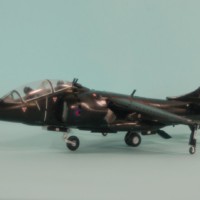
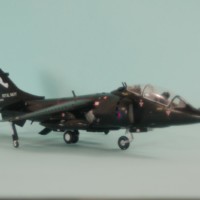
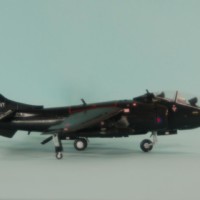
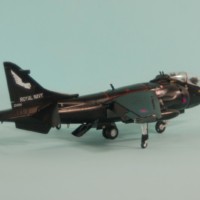

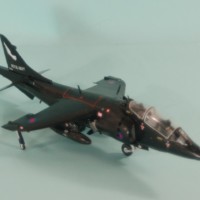

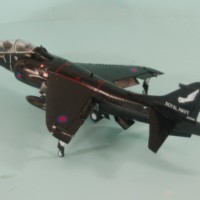
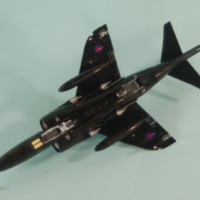
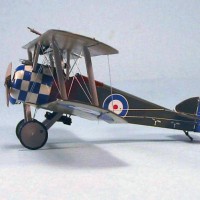
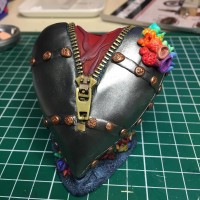
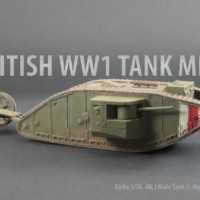
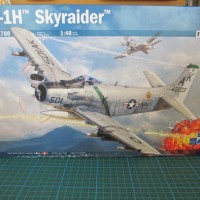
"...the result is very nice..." indeed. I like it.
Tom, thanks for the build article. I was windering how it would build up. looks like another onslaught on the old plastic credit card. Never thought I'd see a two seater.
Hi Tom. For some reason I started reading this without seeing your name as author; about halfway through I was thinking "this is an unusually detailed and engaging review - this guy could give Tom C. a run for his money".
This is a very elegant version of the Harrier, and I enjoyed reading about Sopwith and the pilot experience of this ground breaking jet. Great read and a great build.
ROFLMAO! 🙂
MTFLAI!
Me, too, felt like an i***t.
That’s really slick looking in black, Tom. Thanks for sharing this. I need to get one of these.
I remember watching a Harrier perform at an airshow in the late 1970's / early 1980's. It was quite a sight at the time ! Your model looks great... and a very interesting read. Thanks
The Harrier is undoubtedly an important aircraft in aviation history, many say it was retired from active service too early. I remember watching one performing a "demonstration" at the British F1 Grand Prix at Brands Hatch one year, it blew all the VIP hospitality tents away to much applause from the rest of the crowd.
Jet black black jet. Great job Tom. Looks great.
Great model of a great aircraft, Tom ... as well as an interesting version. As usual, your narrative is interesting and informative.
Looks great! Did your example have a molding flaw in the canopy?
nope
Taciturn Tom.
From al the photos on the net, black is apparently British trainer color the past 20 years or so.
supposed to be to Tom below.
Nicely done Tom, never seen one in black. Looks good.
Really cool build Tom! Your bang right about the pilots... I watched a documentary on the Harriers and all the pilots had to be trained to fly helicopters first before they were let loose in the jet! It's apparently a fine art keeping them level when hovering.
You've got me wanting to build another one now!
Nicely done Tom! First time I’ve seen you build a modern jet
You're right, I mostly like them about as much as I like modern cars. Punch the parameters into the computer and get something indistinguishable from the other something someone punched the parameters into the computer for. Me, I like being able to look at an airplane and see its "design quirks," the signature of the designer, the same as looking at a car and being able to identify it by its design. Was in a parking lot today and couldn't tell a 2017 Jaguar from a 2017 BMW, other than the fact that a piece of something I would scrape off my shoe was driving the BMW (of course) and a well-bred polite person was driving the Jag (of course). But as to the cars, I think there was something about the front ends...
Yep, the Harrier seems to be the only VTOL that really worked. Remember many years ago, seeing one in a high hove near Anaheim I think it was, travelling by train down from LA to San Diego to see a cousin and visit the awesome aviation museum in SD. It just looked all wrong...a jet, hovering! Jets do leave me cold compared to props...but I did build an Airfix 1/72 Tomcat once, and was kind of fond of it, it's such a beast of a fighter.
Nice build Tom! The training version just looks even more like it shouldn't be hanging in the air, especially at "hover" speed. I watched one land in 76/77 at Keesler AFB in Biloxi, and it was fascinating. I really like the Harrier in all its permutations, and have several in the stash beyond the one Marine version I've built, though not a 2-seater yet.
I've never had the opportunity to see a two seat Harrier in person, but hopefully Art Nalls will have his going soon! The two seater does look good in black. I'd build mine that way but I'd also want one in the colorful version (before they went to black insignias and lettering) of VMAT-203 markings to sit alongside Monogram's AV-8A. Didn't read any gripes in the text so this must be a honey to build! Now on my buy list!
Very nice build. I have a soft spot for the Harrier and this 2-seater trainer in all black is just great.